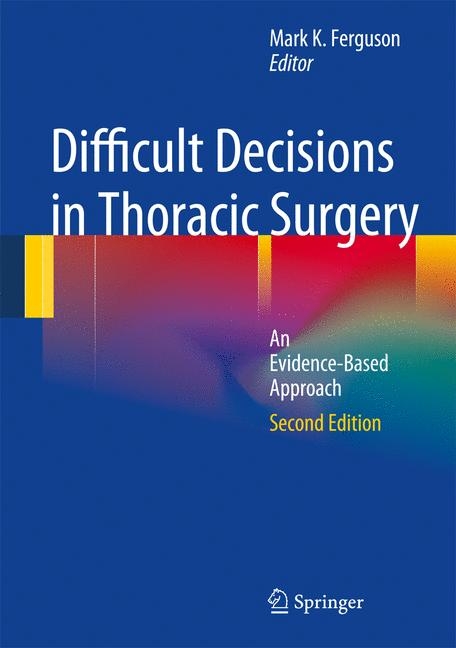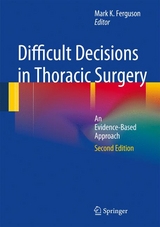Difficult Decisions in Thoracic Surgery
Springer London Ltd (Verlag)
978-1-84996-364-0 (ISBN)
- Keine Verlagsinformationen verfügbar
- Artikel merken
The second edition of Difficult Decisions in Thoracic Surgery: An Evidence- Based Approach addresses the growing complexity of decision making in thoracic surgery. More than half of the clinical questions posed in this book are new, and of the questions that remain as holdovers from the previous edition, virtually all have been revised and updated. As new technology is introduced, physicians from nonsurgical specialties offer alternative and competing therapies for what was once the exclusive province of the thoracic surgeon. In addition, there is increasing knowledge regarding the efficacy of traditional thoracic surgical therapies. How to select among these varied and complex approaches is becoming increasingly difficult. Concise chapters are devoted to one or two specific questions, or decisions, in general thoracic surgery that are difficult or controversial. The authors identify relevant publications in their selected topics, grade the quality of the evidence offered by those reports, apply that knowledge to objective management recommendations in an idealized world, and then comment on how they personally use the information in their own clinical practices.
The book is a valuable reference source for practicing surgeons, surgeons in training, and educators.
Mark K. Ferguson, MD is Professor of Surgery at University of Chicago Medical Center. He specializes in the surgical management of diseases of the lungs and esophagus. He is experienced in all techniques of lung and esophageal resection, and is skilled in surgical methods to relieve airway obstruction and malignant pleural effusions. He has served on the boards and committees of numerous national societies and institutions including the Food and Drug Administration (FDA) and the National Institutes of Health. Dr. Ferguson is the author of more than 75 chapters in medical textbooks. He has edited or written books on esophageal reconstructive surgery, failed anti-reflux therapy, and decision-making in thoracic surgery. He recently authored an atlas of general thoracic surgery. Dr. Ferguson has also written more than 175 papers in medical journals, and serves as an editor or associate editor for three cardiothoracic surgery journals. His research interests include risk analysis and long-term outcomes after lung resection and esophageal resection.
Part 1:Background.- Introduction.- Evidence-based medicine: levels of evidence and evaluation systems.- Decision analytic techniques.- Decision making:the surgeon's perspective.- Decision making - the patient's perspective.- Part 2: Lung.- PET for Mediastinal Restaging of Patients with Non Small Cell Lung Cancer after Induction Therapy.- Optimal Initial Pathologic Mediastinal Staging of Lung Cancer: EUS, EBUS, Mediastinoscopy.- VATS vs. Open Lobectomy for Early Stage Non-Small Cell Lung Cancer.- N2 Disease Discovered at Thoracotomy: Resect or Abort?.- Pulmonary Function Alterations After Induction Therapy for Lung Cancer: Preoperative Considerations.- Lobectomy After Induction Therapy for Stage IIIA NSCLC in the Presence of Persistent N2 Disease.- Pneumonectomy After Induction Therapy for Stage IIIA non-small-cell Lung Cancer.- Segmentectomy Versus Lobectomy for Stage I Lung Cancer in Patients with Good Pulmonary Function.- Optimal Therapy for Patients with Marginal Lung Function and Peripheral Stage I Lung Cancer.- VATS versus Thoracotomy for Major Lung Resection After Induction Therapy.- Chest Tube Management after Lung Resection.- Management of the Pleural Space Early After Pneumonectomy.- Perioperative Prophylaxis Against Venous Thrombo-Embolism in Major Lung Resection.- Perioperative Arrhythmia Prophylaxis for Major Lung Resection.- For Whom Is Lung Volume Reduction Surgery Effective?.- Support Therapy for Lung Failure.- Part 3: Esophagus.- Optimal Management of Barrett Esophagus with High Grade Dysplasia.- Induction Therapy for Resectable Esophageal Cancer.- Optimal Surgical Approach to Esophagectomy for Cancer.- Extent of Lymph Node Dissection in Esophageal Cancer.- Salvage Esophagectomy for Persistent Disease After Definitive Chemoradiotherapy.- Barrett Mucosa in the Cervical Remnant After Esophagectomy for Cancer.- Partial or Total Fundoplication for GERD in the Presence of Impaired Esophageal Motility.- Surgical management of Non-acid Reflux Unresponsive to Medical Therapy.- Prophylactic Antireflux Surgery in Lung Transplantation.- Optimal Initial Therapy for Achalasia.- Stenting for Esophageal Perforation and Anastomotic Leak.- Lengthening Gastroplasty for Managing GERD and Giant Paraesophageal Hernia.- Optimal Therapy for Cricopharyngeal Diverticula.- Management of Distal Esophageal Pulsion Diverticula.- Part 4: Diaphragm.- Giant Paraesophageal Hernia: Optimal Surgical Approach.- Diaphragm Pacing for Acute Respiratory Failure.- Synthetic Reinforcement of Diaphragm Closure for Large Hiatal Hernia Repair.- Part 5: Airway.- Stents for Benign Airway Obstruction.- Tracheal Reconstruction with Autologous and Engineered Tissues.- Optimal Management of Malacic Airway Syndromes.- Carinal Resection for Cancer.- Use of Sealants to Reduce Air Leak Duration and Hospital Stay after Lung Resection.- Optimal Initial Therapy for Pleural Empyema.- Management of Malignant Pleural Effusion: Sclerosis or Chronic Tube Drainage.- The role of VATS Pleurodesis in the Management of Initial Primary Spontaneous Pneumothorax.- Malignant Pleural Mesothelioma: Patient Selection for Pleurectomy.- Malignant Pleural Mesothelioma - Patient Selection for Extrapleural Pneumonectomy.- Thymectomy for Myathenias Gravis.- Optimal Surgical Approach and Extent of Resection of the Thymus in Patients with Myasthenia Gravis.- The Optimal Approach for Resection of Encapsulated Thymoma: Open vs. VATS.- Management of Residual Disease After Therapy for Mediastinal Germ Cell Tumor and Normal Serum Markers.- Symptomatic Malignant Pericardial Effusion: Surgical or Percutaneous Drainage?.- Bronchogenic and Pericardial Cysts: Resect or Observe.- Patient Selection and Optimal Extent of Surgery for Hyperhidrosis .- Pectus Excavatum in the Adult: Current Treatment Modalities.- Traumatic Rib Fracture: Conservative Therapy or Surgical Fixation?.
| Erscheint lt. Verlag | 7.1.2011 |
|---|---|
| Zusatzinfo | 20 black & white illustrations, 121 black & white tables, biography |
| Verlagsort | England |
| Sprache | englisch |
| Maße | 178 x 254 mm |
| Gewicht | 1126 g |
| Themenwelt | Medizinische Fachgebiete ► Chirurgie ► Herz- / Thorax- / Gefäßchirurgie |
| ISBN-10 | 1-84996-364-9 / 1849963649 |
| ISBN-13 | 978-1-84996-364-0 / 9781849963640 |
| Zustand | Neuware |
| Informationen gemäß Produktsicherheitsverordnung (GPSR) | |
| Haben Sie eine Frage zum Produkt? |
aus dem Bereich




